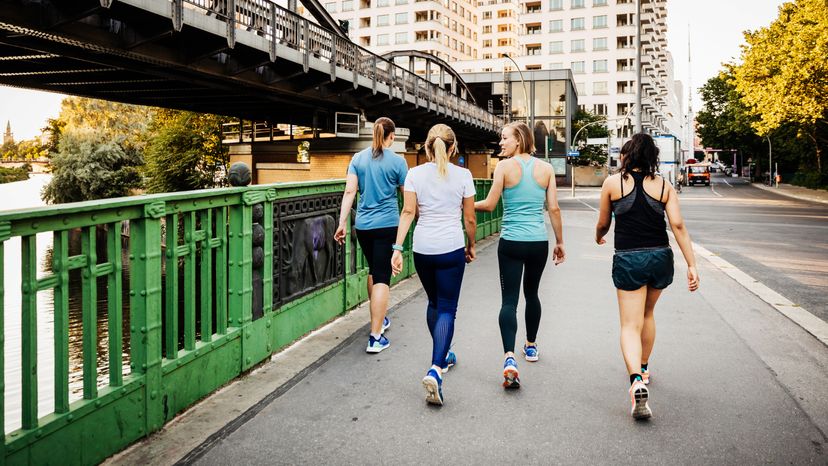By exercising within your target heart rate range for at least 20 to 30 minutes, three or more days a week, you can safely and effectively increase your aerobic fitness. We recommend that you work up to the target range gradually by following the walking programs outlined in this article.
To check your heart rate, you need a watch that measures seconds, not just minutes. You can take your pulse either at the radial artery in your wrist (on the inner side of your wrist, below the heel of your hand) or the carotid artery in your neck (just to the side of the throat). Use the index and middle fingers of one hand to feel the pulse. If you use the artery in your neck, however, place your fingers gently; putting too much pressure on this artery can actually slow your pulse and give you a false reading.
When you've found your pulse, count the number of beats for ten seconds. Then multiply that number by six to find your heart rate in beats per minute. If you have trouble taking your pulse, you may want to purchase an inexpensive stethoscope that allows you to hear your heartbeat or use an automated pulse meter.
To find your optimum level of exertion during exercise, use your maximum heart rate reserve. Exercising at 40 percent to 85 percent of your maximum heart rate reserve will give you a healthy aerobic workout. We've outlined a simple formula that you can use to calculate it:
- Measure your resting heart rate by counting your pulse for ten seconds and multiplying that number by six. (Be sure to do this when you're resting.)
- Subtract your resting heart rate from your maximum heart rate. (As discussed in the previous section, you can find your maximum heart rate through an exercise stress test or by subtracting your age from 220.)
- Multiply your maximum heart rate reserve (the result from step two) by .4 (40 percent) and add that to your resting heart rate to find the lower limit of your target heart rate range.
- Multiply your maximum heart rate reserve (the result from step two) by .85 (85 percent) and add that to your resting heart rate to find the upper limit of your target heart rate range.
You can use this method as a guide throughout the walking programs in the next chapter. By exercising at 40 percent to 85 percent of your maximum heart rate reserve for at least 20 to 30 minutes a day, 3 times a week or more, you can develop and maintain your aerobic fitness.
Since freestyle walking is only a moderately intense exercise, however, it may not be intense enough to get your heart rate into the upper end of your target range. So you may have to walk longer (for 30 minutes or more) and more often (most days) -- or progress to racewalking, hiking hilly terrain, or walking with weights -- to achieve the same benefit as you would by exercising at a higher heart rate.
As you'll see, the walking programs in this book are designed to gradually get you to your optimum level of exercise. At first, you'll walk at a comfortable pace, one that may not get your heart rate in the target zone. Then you will gradually work your heart rate into the target zone.
By progressing slowly, you'll decrease your risk of injury. You'll also be more likely to stick with the exercise program. As your fitness increases, you will notice two telltale signs. It will take more exercise--or more intense exercise--to raise your heart rate into the target zone. And your resting heart rate will decline.
A word of caution: Don't be a slave to your pulse, measuring it so often that it becomes a compulsion. Don't let taking your pulse destroy your sense of fun and spontaneity in exercise. When you first begin your walking program, you may want to take your pulse as often as every 10 or 15 minutes so that you can get a feel for how hard your body is working. Keep in mind, though, that your heart rate begins to slow within 15 seconds of when you stop walking, so try to check your pulse quickly and then get back to walking.
As you progress through the program, you can take your pulse only every 20 to 30 minutes to be sure you're working in your target range. In time, you may only need to check your pulse at the beginning and end of your workout; you may be able to tell whether you're working in your target range just by the way you feel.
As a matter of fact, one of the tools used by exercise scientists to measure and prescribe exercise is something called the rating of perceived exertion (RPE) scale. The exerciser rates how hard he feels he is working, using a 15-point scale that goes from 6 (resting) to 20 (very, very hard).
This rating scale has been found to correlate well with physiological indicators of fatigue or strain, including heart rate and oxygen uptake. In other words, you can use your perception of how hard you're exercising as a guide. If you really feel like you're walking at a moderately intense pace, you probably are; a measurement of your heart rate would probably confirm that you're working in the moderately intense range of 40 percent to 85 percent of your maximum heart rate reserve.
By checking your pulse more frequently during the early stages of your walking program, you'll get a feel for how your body reacts to different levels of exertion; later, you'll be able to judge your exertion without having to stop and check your pulse every ten minutes.
There are other factors to consider to ensure your safety while walking. Read on to learn how to prevent the risks of overexertion, injury, and fatigue.
To learn more about walking, see:
